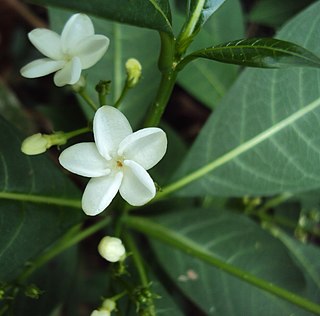Cotylelobium melanoxylon is a tree in the family Dipterocarpaceae. The specific epithet melanoxylon means "black wood", referring to the dark colour of the tree's wood. It was first described by Joseph Dalton Hooker in 1860 as Anisoptera melanoxylon and transferred to Cotylelobium by Jean Baptiste Louis Pierre in 1889. It is the provincial tree of Surat Thani Province, Thailand.

Anisoptera laevis is a tree in the family Dipterocarpaceae. The specific epithet laevis means "smooth", referring to the leaves.
Anisoptera marginata is a tree in the family Dipterocarpaceae. The specific epithet marginata means "bordered", referring to the leaf veins.

Hopea beccariana is a species of tree in the family Dipterocarpaceae. It is named for the Italian botanist Odoardo Beccari.
Hopea griffithii is a tree in the family Dipterocarpaceae. It is named for the British doctor and naturalist William Griffith.
Hopea pedicellata is a tree in the family Dipterocarpaceae. The specific epithet pedicellata, refers to the species' prominent pedicel.
Hopea pentanervia is a tree in the family Dipterocarpaceae, native to Borneo. The specific epithet pentanervia means "five-nerved", referring to the species' five pairs of leaf veins.
Hopea sangal is a tree in the family Dipterocarpaceae. It is native to tropical Asia.
Hopea semicuneata is a tree in the family Dipterocarpaceae. The specific epithet semicuneata means "half wedge-shaped", referring to the leaf base.
Cotylelobium lanceolatum is a tree in the family Dipterocarpaceae. The specific epithet lanceolatum means "lance-like", referring to the shape of the leaf.

Rauvolfia verticillata, the common devil pepper, is a plant in the family Apocynaceae. The specific epithet verticillata means 'whorled' and refers to the plant's leaves.
Dipterocarpus oblongifolius is a species of tree in the family Dipterocarpaceae. The specific epithet oblongifolius is from the Latin meaning 'oblong leaves'.
Hopea dryobalanoides is a tree in the family Dipterocarpaceae. The specific epithet dryobalanoides means "resembling Dryobalanops", referring to that genus of trees and particularly their leaf veins.
Hopea tenuinervula is a tree in the family Dipterocarpaceae, native to Borneo. The specific epithet tenuinervula means 'slender nerve', referring to the leaf veins.
Richetia collaris is a tree in the family Dipterocarpaceae, native to Borneo. The specific epithet collaris means 'neck' and refers to the calyx of the fruit.
Shorea coriacea is a tree in the family Dipterocarpaceae, native to Borneo. The specific epithet coriacea means 'leathery' and refers to the leaves.
Shorea havilandii is a tree in the family Dipterocarpaceae, native to Borneo. It is named for the English naturalist George Darby Haviland.
Reinwardtiodendron kinabaluense is a tree in the family Meliaceae, native to Borneo. It is named for Mount Kinabalu.
Lophopetalum pallidum is a tree in the family Celastraceae. The specific epithet pallidum means 'pale', referring to the leaves when dry.
Microtropis valida is a plant in the family Celastraceae. The specific epithet valida means 'growing strongly'.



